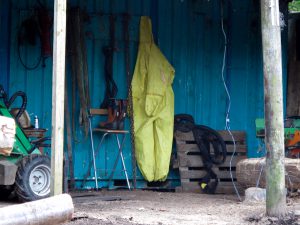While shopping in Hexham in preparation for the Bank Holiday, I bought a book in Eland’s ’Poetry of Place’ series, Highlands and Islands (2012), edited by Mary Miers. I picked it up because of my ongoing desire to reorient my work in relation to evoking place. I’m trying to combine elements of the relatively ‘prose-oriented’ approach of my former deep mapping work with a small-scale approach that’s closer to the visual ‘poetics’ I associate with the best painting. (In addition to paintings I’ve long admired – particularly by Paula Rego, Ken Kiff and R. B. Kitaj’s early work – I’ve also been looking very carefully again at the work of Prunella Clough, Helen Frankenthaler, Peter Lanyon, and various others).
This project is not, of course, simply about starting to make painted constructions that try to evoke place. It seems to me to require, among other things, adopting a degree of critical solicitude towards reflecting on the complex of family and social circumstances that lie behind my own preoccupation with the Scottish Highlands and Islands. That preoccupation, which has brought with it an abiding concern with upland farming communities throughout the United Kingdom, is central to my work as a visual maker and a writer. Such complexities and their implications seem to me inseparable from considerations of place and so must be addressed if one wishes to distinguish between work that engages with landscape and work that tries to evoke a sense of place.
That thought is prompted by my reading Highlands and Islands. Scanning through the book I found Kathleen Raine’s Message to Gavin (1969), a reminder of both the doomed relationship between the poet (Kathleen Raine) and the novelist (Gavin Maxwell) and of my own contact with them both in late childhood and early adolescence. (A visit with my parents to Camusfeàrna, as Maxwell called his Sandaig cottage, made a very powerful impression on me, as much because of the difficulty of finding that beautiful place, and the size of his two dogs when we did, as with meeting the author of Ring of Bright Water. Among other encounters with Kathleen Raine, her withering dismissal, delivered in her tiny Chelsea flat, of my adolescent preference for Rothko paintings over those of Bacon, is equally memorable).
There is much like about Highlands and Islands. It contains, for example, unexpected work I did not know. This includes a poem by T. S. Eliot – Rannoch, by Glencoe – which illuminates a place I know, both from childhood journeys and a memorable trip with my two sons, and is part of an ongoing conversation with friends. I also find the book helpful in terms of thinking about reorienting my own work, particularly the way in which each poem is contextualised. This contextualisation serves to remind me of all the different ways in which a poem is grounded in, grows out of, and interacts with, lives that unfold in all the weave of richness and complexity that makes up place. Not just the way in which Hugh MacDiarmid’s A Little White Rose counterpoints his thinking with that of W. B. Yeats, and is taken up by Alex Salmond, but the whole politics of landownership. And so the ways in which these interact with the presuppositions of class, entitlement and attitudes to relationships to the inter-woven-ness of personal, social and environmental realities.
A good deal to think about then.
